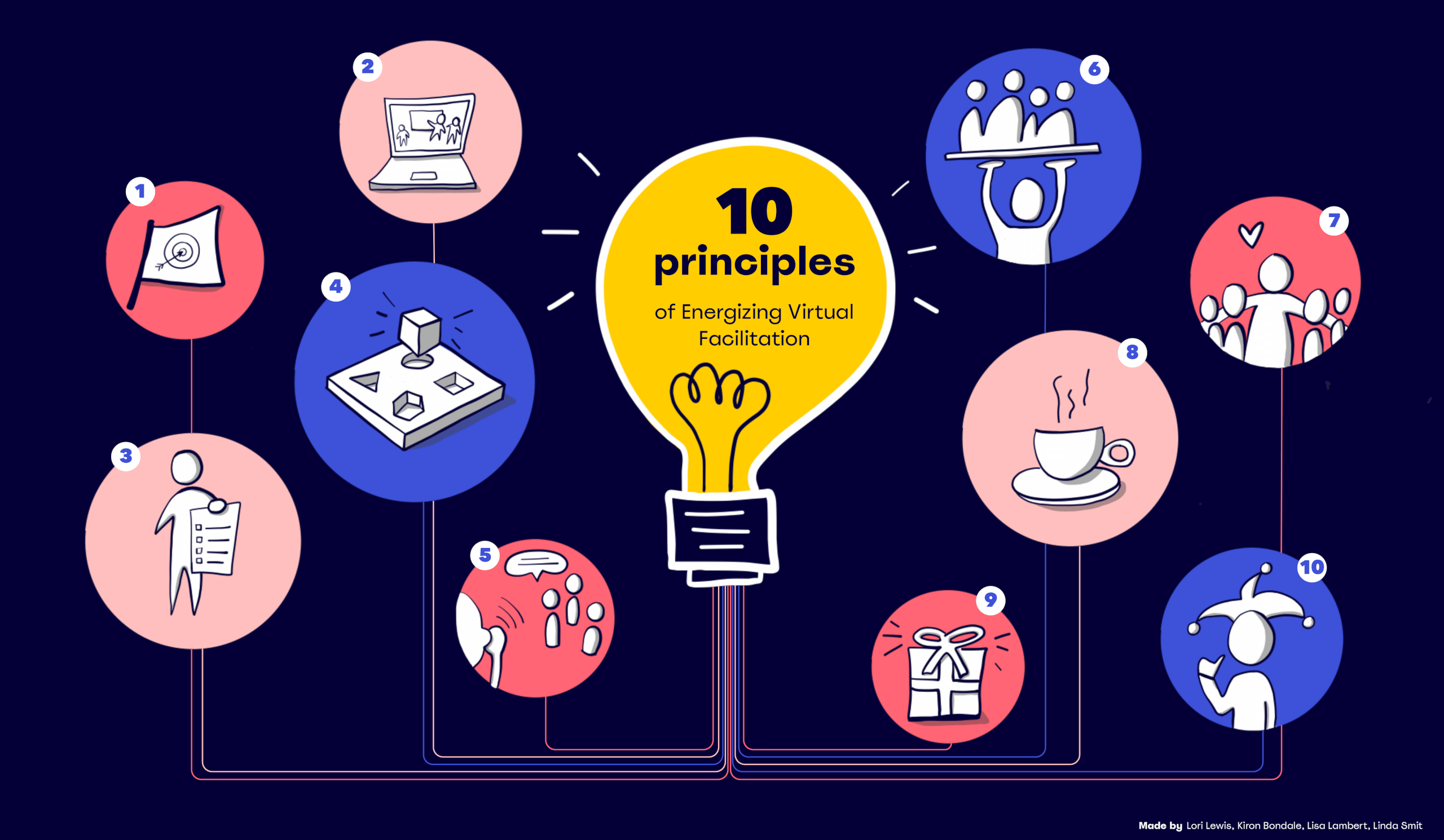Is there really a need to write another article about improving virtual events?
It is more than a year into the COVID-19 pandemic, so it is safe to say that most of us have likely had our fill of virtual events. Whether running a virtual session or contributing to one, we have all earned our merit badges for learning the ins and outs of a myriad of video conferencing, persistent chat, instant messaging, and live virtual collaboration tools.
But does that mean our events are consistently hitting the mark? Sadly, no. Too often people leave a session with less energy than when they started the session. Zoom fatigue remains ever present despite all the articles, YouTube videos, and seminars conducted on how to run effective virtual meetings.
Principles over practices
While those resources are helpful, too many of them focus on specific practices, tools, and techniques for facilitation that neglect the overall energy flow throughout a session. So rather than cover the “how” of effective virtual facilitation, let’s delve into the “what” and “why” by taking a principles-based approach to the topic. While practices and tools are context-specific, principles are (mostly) universally applicable and provide a powerful lens to tailor the design of your virtual event to best serve your people and your purpose.
The following set of 10 guiding principles of energizing virtual facilitation won’t satisfy the principles (no pun intended) of mutual exclusivity and collective exhaustion. There are overlaps between some of the principles but sufficient value in each to offset redundancies. There is also no priority to the list — the merits of each complement one another. Our intent was to get to the core of what makes for great virtual facilitation so you can effectively design sessions that are engaging and energizing rather than exhausting.
10 guiding principles of energizing virtual facilitation
- Get clear and aligned about your goals and desired outcomes before you choose the process and tools.
- Remember this is virtual facilitation, and not in-person facilitation.
- Set clear expectations about the rules of engagement.
- Context counts, so take it into account.
- Meet people where they are and practice empathy.
- Set your participants up to be the heroes of the experience.
- Take care of your people.
- Know when it’s time to push just a bit more and when it’s time to take a break.
- Don’t be boring!
- Don’t take yourself too seriously!

1. Get clear and aligned about your goals and desired outcomes before you choose the process and tools.
As Simon Sinek would say, “start with why.” It can be very tempting to jump right into designing the “what” and “how” of an event, but have you spent sufficient time exploring the event’s purpose? “Why” is the event being held and what do you want your participants to get out of it?
While virtual collaboration platforms are ideal when we want to design or build something together, if all we are doing is sharing information in one direction, then consider skipping the event and leveraging an asynchronous means of communication instead like sharing a video, a message, a presentation, and so on.
Before greenlighting your event, take the time to ensure you have a clear understanding of the desired outcomes and then pick the methods and medium to best achieve those outcomes.
2. Remember this is virtual facilitation, and not in-person facilitation.
While there is significant diversity and capabilities within tools to support all types of virtual events, they are still not the same experience as their in-person counterparts. Sure, there are some constraints with virtual, but there are also an abundance of possibilities to experiment with new ways to reimagine what virtual events could be.
As a facilitator, it’s important to get acquainted with a handful of virtual facilitation tools (e.g., Miro and a videoconference solution) and facilitation techniques so that you are familiar with the building blocks you have available to design extraordinary energizing virtual experiences.
In a virtual context, you may not be able to readily read the “energy in the room,” but that doesn’t mean you can’t influence the energy levels to better engage your participants. Don’t hesitate to leverage features like breakout rooms, polls, reaction and engagement capabilities, and much more to shake up the energy and pacing while creating a multitude of ways for participants to engage during the event.
3. Set clear expectations about the rules of engagement.
When any group of people gathers together, there is potential for misunderstandings to occur. This can be especially true as new groups come together and trust and psychological safety are yet to be established.
As a facilitator, you have a responsibility to help establish this trust and psychological safety. You are in a great position to also help them minimize the risk of misunderstandings. A powerful way to do all this is by helping the group develop a clear, shared understanding of how they will work together. While you can help to get the ball rolling with some simple ones (e.g., the frequency and duration of breaks, what is discussed in the room stays in the room), it’s important that the participants feel a sense of ownership and accountability for the working agreements, so invite them to contribute some of their own.
Ensure that the working agreements are readily visible and accessible to all, and if the event is spanning multiple days, take the time at the start of each day to remind everyone of the agreed upon rules of engagement and give them the opportunity to update them based on learnings from the previous day.
4. Context counts, so take it into account.
Everything is contextual and context changes how each of us interpret our experiences.
Remember that your virtual event is happening within other contexts. Understanding these is crucial to designing and facilitating intentional experiences for all involved. When it comes to context, be mindful to consider:
- What is happening in the external environment surrounding — whether that’s the organization, the team culture, the timing, a bigger decision or project, world events, etc.
- The personal context each of your participants brings with them.
5. Meet people where they are and practice empathy.
While in an ideal world, as a facilitator, we’d have everyone’s full attention throughout our event, the reality is that this likely won’t be the case. As a facilitator, it’s crucial to be understanding of your participants’ human needs and individual realities.
As work and home lives have blended for many this past year, your participants may be juggling work and personal priorities. Additionally, not everyone has the same technical or physical fluency with virtual work which we do. Based on their personal situation, they might be dealing with Internet-access issues, older devices, or other constraints which will limit their full participation.
Rather than making negative assumptions about why a participant might not be as engaged as you’d like them to be, give them the benefit of the doubt and consider what your participant might be experiencing and feeling through their point of view.
This need to practice empathy applies not just to us as facilitators but to all participants. To encourage this collective practice, consider baking it into the working agreements for the event, checking in regularly with participants, providing support for those who are struggling, and holding space in a personable and inviting manner for each person to participate as best they can.
6. Set your participants up to be the heroes of the experience.
Your virtual event isn’t about you: it’s about your participants. A successful event is one where participants feel they have succeeded.
Recognize that different people have different strengths, learning styles, and ways of showing up as their best selves, so your approach to the event needs to provide opportunities for everyone to shine and succeed. Pay attention to your participants so you can notice their individual superpowers, and if you can, try to get a sense of these before your event.
Consider building in mini-celebrations to recognize everyone’s contributions (e.g., using the virtual reaction icons or sharing appreciations) and be mindful to include and acknowledge each and every participant.
7. Take care of your people.
It doesn’t matter if you achieve your outcomes if you left some of the group behind. If your participants are tired, confused, or frustrated, you won’t achieve this goal.
Consider building in checkpoints at key places during your event to see how everyone is doing so you can readily create a safe space for participants to express any concerns they may feel candidly. It’s important to pay attention to what isn’t said — is someone pushing back from their desk or are they off camera for a prolonged period? Follow up with your participants afterwards to understand whether they felt they were “heard” and valued and that they trusted that the group members were genuinely interested in their well-being.
Don’t assume that just because one person is okay or wants something changed that everyone does. This is an important opportunity to really practice your facilitation skills so you can both take care of your people and the best interests of the larger group.
8. Know when it’s time to push just a bit more and when it’s time to take a break.
Each person is unique when it comes to the energy they will bring to your session and how that energy gets depleted or recharged. Virtual sessions require greater focus than in-person ones, so participants will benefit from frequent physical and mental breaks.
It might be tempting to push through just to complete an agenda item, but the benefit you will get of staying on track risks being lost by the negative effects of participant disengagement. If the group is on the verge of a breakthrough or you think they can accomplish something in the next few minutes, ask for their permission to do this and go with the majority’s decision.
When using virtual collaboration tools, consider encouraging participants to use a coffee cup reaction or similar visual indicator to show that they need a break.
9. Don’t be boring!
Variety is the spice of life and that saying is even more relevant with virtual events.
With in-person events, you have the benefit of a captive audience in the room with you, so it’s easier to identify if participants are tuning you out. But even with small virtual sessions, unless everyone has their cameras and microphones on 100% of the time, you won’t gain the same insights.
Remember that human attention spans are less than that of a goldfish, so shake things up. Even if you have a virtual event, try to incorporate all of your participants’ senses in the process to activate different parts of their brains. Audio and video can help, but nothing beats active participation, including moving around!
10. Don’t take yourself too seriously!
Laugh, and the world laughs with you.
Regardless of the purpose of your session, find a way to incorporate some levity. For example, a humorous anecdote, video clip, or ice breaker could be a breath of fresh air. And don’t just lead with those, incorporate them throughout your agenda at regular intervals. Play and humor are powerful tools to build team trust and connection. (Quick caution: be considerate of your audience when it comes to sense of humor.)
The likelihood of something going wrong increases with the scale and importance of an event. Expect the unexpected, and when the unexpected strikes, don’t lose the opportunity to make light of the situation. Don’t worry about being a world-class standup comedian — being human is all that’s needed. But know your audience and keep it professional!
Putting the 10 guiding principles of energizing virtual facilitation into practice
Virtual events are integral to the future of work. Embracing these 10 guiding principles of energizing virtual facilitation will help you design virtual events that engage, inspire, and delight.




